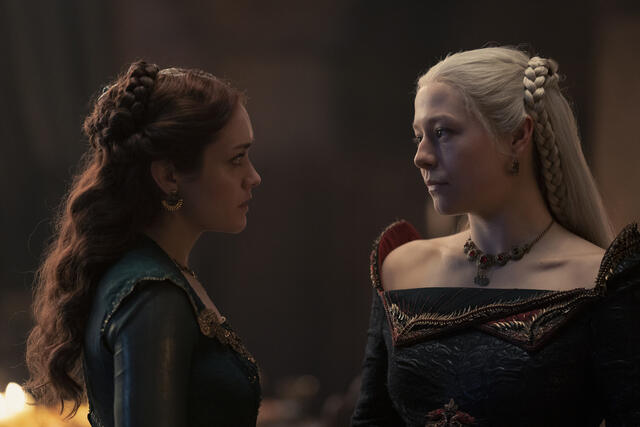In House of the Dragon, the prequel to Game of Thrones set roughly 200 years before the eight-season epic, viewers will look upon Daenerys Targaryen’s ancestors basking in the height of their power.
HBO’s Game of Thrones introduced the Mother of Dragons, Daenerys (Emilia Clarke), the last of her bloodline desperate to regain the former glory of the Targaryen dynasty.
The Targaryens ruled Westeros for some 300 years. When House of the Dragon opens, we meet them about 100 years into their reign, smack-dab in the middle of George R.R. Martin’s Fire & Blood, which outlines the history of the Targaryen kings.
King Viserys I Targaryen (Paddy Considine) is at a crossroads. Though the Seven Kingdoms are stable and peaceful, Viserys is grappling with questions of succession.
His sole living child is Rhaenyra (Milly Alcock as a teen, Emma D’Arcy as an adult), a teenage girl that no one in the kingdom deems an acceptable choice for an heir. However, Viserys’ younger brother, Daemon (Matt Smith), who revels in chaos and confusion, might not have the temperament to sit on the Iron Throne.
Female characters have always been important in Martin’s world, but their stories were often riddled with sexual violence, pain, and terror in Game of Thrones. Now with Princess Rhaenerya, her closest confidant (at first), Alicent Hightower (Emily Carey and later Olivia Cooke), and Princess Rhaenys Targaryen (Eve Best), Viserys’ cousin, the “Queen Who Never Was,” women are setting Westeros aflame.
Ahead of the series premiere, Shadow and Act spoke with Alcock, D’Arcy, Care, and Cooke about power dynamics, having a distinct gaze, and why the actors portraying the same characters were kept separate from each other.
“The lack of dialogue between women, I think, spoke louder than any monologue could have had,” Alcock said about the sexism and misogyny that female characters of this era must contend with. “It really touched upon the fact that these women were pitted against each other.”
Though the women in House of Dragon are left to form their own alliances to seek power, the actors’ male colleagues offered true partnership on the set. “Alicent’s key relationship is between her and her father,” Carey explained. “Rhys [Ifans] was such a help in that. Alicent and Otto love each other dearly, but they don’t know how to express it. It comes out in anger whenever they want to say that they love each other or miss each other. Hightower is fiery. They’re passionate people, and often that passion comes out in anger rather than love. I think the relationship between these two is a key example of that.”
Like the Hightowers, Rhaenyra and Viserys have their own struggles and traumas they must push through for the greater good. For Alcock, working with Considine during those challenging scenes was a gift.
“I think that Rhaenyra and Viserys’ dynamic is so interesting because there becomes such a shift within it,” she explained. “She learns how to empathize with him and him with her, and ultimately, these two people want to communicate, but they don’t know how to. There’s something that’s so heartbreaking about that.”
Though House of the Dragon, like its predecessor, depicts a particular time and place, the original show was heavily critiqued for its depictions of violence against women. It was something that D’Arcy and Cooke were very aware of.
“One of the things is about like, ‘Who’s gaze?'” D’Arcy said. “This is a show interrogating what it is to be a woman within a repressive patriarchal structure. When there are difficult scenes, they are part of that narrative exploration that strives toward a slightly different gaze. The other side is how that is then managed practically on set. We work with an intimacy coordinator.”
Co-showrunners Ryan J. Condal and Miguel Sapochnik were adamant about being loyalists to Martin’s written world, but not for the sake of exploitation. “There’s no point at having sex and brutality for titillation alone,” Cooke said. “It has to be because it serves the story and is indicative of the world. That’s what it felt that the creators were actively trying to do. Everything would be rehearsed beforehand.”
Although Alcock and D’Arcy portray Princess Rhaenyra and Carey and Cooke portray Alicent at different stages in the characters’ lives, the actors and the performances were kept separate. “We didn’t feel that we could encroach on their performance or their methods cause they in their own right are playing completely separate characters to who you meet 10 years down the road,” D’Arcy explained. “There’s a beautiful through line between the two versions.”
Though the dual casting certainly seemed like a risk, in the end, it made House of the Dragon feel even more authentic. “We finally saw the first episode, and it felt a bit like watching Targaryen home video and seeing something of yourself as a child,” Cooke said. “On the one hand, you feel that person to be familiar and have deep empathy for them in their position, but sometimes you feel distinctly different and separate. Fortunately, it functions really well.”
House of the Dragon premieres on August 21, 2022 on HBO.
Aramide A. Tinubu is a film critic, consultant and entertainment editor. As a journalist, her work has been published in Netflix’s Tudum, EBONY, JET, ESSENCE, Bustle, The Daily Mail, IndieWire and Blavity. She wrote her master’s thesis on Black Girlhood and Parental Loss in Contemporary Black American Cinema. She’s a cinephile, bookworm, blogger and NYU + Columbia University alum.

